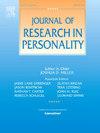说谎的朋友:自我和朋友对诚实的感知以及与诚实相邻的特征
IF 2.6
2区 心理学
Q2 PSYCHOLOGY, SOCIAL
引用次数: 0
摘要
使用来自193个友谊四组的循环数据,我们调查了朋友之间在诚实和诚实相关(即诚实-谦卑)判断方面的共识和偏见。参与者根据三个直接诚实量表和诚实-谦卑特质量表给自己和每个朋友打分。社会关系模型分析显示,相对于五大特征,诚实和诚实-谦卑的一致性较低,这表明朋友之间对谁诚实的共识有限。感知差异和关系差异解释了大多数差异:感知差异(例如,通常将人们评为相似的[不]真诚)解释了更多的诚实-谦卑评级,关系差异(源于二人组的独特关系)解释了更多的直接诚实措施。自我与他人的一致性在测量中较低,而假设相似性较高。讨论了诚信和友谊研究的意义。本文章由计算机程序翻译,如有差异,请以英文原文为准。
Fibbing friends: self and friend perceptions of honesty and honesty-adjacent characteristics
Using round-robin data from 193 friendship quads, we investigated consensus and bias in honesty and honesty-related (i.e., honesty-humility) judgments among friends. Participants rated themselves and each friend on three direct honesty scales and the honesty-humility trait scale. Social Relations Model analyses showed low consensus for honesty and honesty-humility relative to the Big Five traits, indicating limited agreement among friends on who is honest. Perceiver and relationship variance explained most variance: perceiver variance (e.g., generally rating people as similarly [un]sincere) explained more of the honesty-humility ratings and relationship variance (originating from the dyad’s unique relationships) explained more of the direct honesty measures. Self-other agreement was low across measures, whereas assumed similarity was high. Implications for honesty and friendship research are discussed.
求助全文
通过发布文献求助,成功后即可免费获取论文全文。
去求助
来源期刊

Journal of Research in Personality
PSYCHOLOGY, SOCIAL-
CiteScore
5.40
自引率
6.10%
发文量
102
审稿时长
67 days
期刊介绍:
Emphasizing experimental and descriptive research, the Journal of Research in Personality presents articles that examine important issues in the field of personality and in related fields basic to the understanding of personality. The subject matter includes treatments of genetic, physiological, motivational, learning, perceptual, cognitive, and social processes of both normal and abnormal kinds in human and animal subjects. Features: • Papers that present integrated sets of studies that address significant theoretical issues relating to personality. • Theoretical papers and critical reviews of current experimental and methodological interest. • Single, well-designed studies of an innovative nature. • Brief reports, including replication or null result studies of previously reported findings, or a well-designed studies addressing questions of limited scope.
 求助内容:
求助内容: 应助结果提醒方式:
应助结果提醒方式:


